
It's assumed barrel length and velocity walk hand in hand, but in reality, there are many other variables at play.
What You Need To Know About Barrel Length And Velocity:
- The assumed 25 fps velocity increase per inch of barrel, in most cases, proves a wive's tale.
- Tests on barrel length/velocity are often very limited in scope and overall add up to simple guesses.
- Other factors — chamber dimension, bore dimension — also play a role in velocity.
- Burn rate of powder can be an especially important factor in velocity.
There’s a lot of discussion about how barrel length can affect velocity. It can be important, particularly with defensive handgun cartridges, because you need enough velocity to make the bullet expand. And, too, velocity has an impact on wounding potential. The problem with blanket estimations is that they’re only that — estimates. If you base your beliefs on estimates or guesses, you could be considered delusional.
The main problem with the blanket estimate is that some guns generate higher or lower muzzle velocities than anticipated. This is due to variations in actual bore dimensions. Chamber dimensions also vary and affect pressure, which translates to velocity. To say a particular load will generate a certain velocity from a specific barrel length — based on what it generated in another barrel length — is nothing but a guess.
Still, we make assumptions, and we do this based on averages. Tests to support these conclusions are often conducted by using one load, as well as cutting a barrel off — an inch at a time — and then measuring the velocity at each length. I’m not much for cutting guns into pieces, but fortunately, I have some data that might shed some light on how much guessing we’ve been doing.
Smashing Other Ballistic Myths:
- .45 ACP vs 9mm: Which Is Better?
- Are Ballistic Gel Penetration Tests Gospel?
- What You Need To Know About Handgun Stopping Power
- Bullet Expansion: Velocity Is The Deciding Factor
- Is Sectional Density A Good Measure Of A Bullet’s Penetration Potential?
I’d tested eight .32 H&R Magnum and nine .327 Federal Magnum factory loads in four different firearms, with barrel lengths ranging from 3 to 16 inches. What you’ve been told or thought was fact all these years might just be a wild guess … or, well, complete BS.
Comparing 17 loads out of two revolvers with a 3.0- and a 4.6-inch barrel, respectively, I found that seven of the loads produced a lower velocity from the longer barrel. The average increase in velocity from a barrel 1.6 inches longer was only 12.47 fps, or 1.03 percent. This illustrates how different guns can produce radically different velocities. The learning point here is that just because you choose a handgun with a barrel 1.5 inches longer than another does not mean it will generate higher velocities.

Comparing the 3-inch-barreled revolver to one with a 5.5-inch barrel produced much more conventionally acceptable results. Here, the average velocity gain was 142.2 fps, which is an average increase of 56.88 fps per inch. But, again, we’re making a broad estimate. One load showed a gain of only 39 fps; another showed an increase of 414 fps!
Why the tremendous discrepancy? Gunpowder mostly. Some powders burn very fast and reach peak pressure — peak velocity — very soon. Others take more time.
On average, the velocity increase from a 3-inch to a 16-inch barrel was 487.7 fps, which works out to 37.51 fps per inch of barrel. That’s closer to the assumed 25 fps per inch of barrel most expect to see. But here, again, that’s not a reasonable depiction of the difference. One load only generated 1,340 fps from the 3-inch barrel but blistered out of the 16-inch barrel at 2,155 fps. That’s a 60.82 percent (815 fps) velocity gain, or 62.69 fps per inch of barrel. Another load only showed an increase of 262 fps — 20.15 fps per barrel-inch — which is well below the 487 fps average.
The main takeaway from all of this is that you cannot use some arbitrary experiment or number to make a blanket prediction about barrel length and velocity. Every load is different, and every gun is different. Some loads need more barrel to deliver maximum performance, and some guns — due to dimensional variations — will produce lower- or higher-than-expected velocities. The often-trusted 25 fps per inch of barrel length is an old wives’ tale, and, well … complete BS.
Editor's Note: This article originally appeared in the May 2019 issue of Gun Digest the Magazine.

Next Step: Get your FREE Printable Target Pack
Enhance your shooting precision with our 62 MOA Targets, perfect for rifles and handguns. Crafted in collaboration with Storm Tactical for accuracy and versatility.
Subscribe to the Gun Digest email newsletter and get your downloadable target pack sent straight to your inbox. Stay updated with the latest firearms info in the industry.

![Best Concealed Carry Guns In 2025 [Field Tested] Wilson Combat EDC X9S 1](https://gundigest.com/wp-content/uploads/Wilson-Combat-EDC-X9S-1-324x160.jpg)


![Best 9mm Carbine: Affordable PCCs [Tested] Ruger Carbine Shooting](https://gundigest.com/wp-content/uploads/Ruger-Carbine-Shooting-100x70.jpg)
![Best AR-15: Top Options Available Today [Field Tested] Harrington and Richardson PSA XM177E2 feature](https://gundigest.com/wp-content/uploads/Harrington-and-Richardson-PSA-XM177E2-feature-100x70.jpg)

Using revolvers, which have an open space between the chamber and barrel, for barrel length velocity tests is the least consistent and least scientificly valid method available. Period.
Even two different revolvers of the same make and model could produce significantly different results unless you’re using very high-end tight tolerance models.
certainly makes a difference in an M-16….